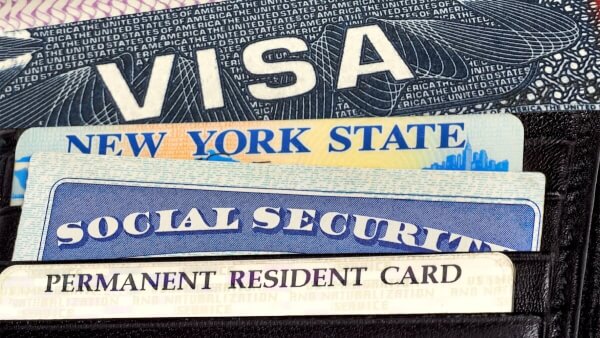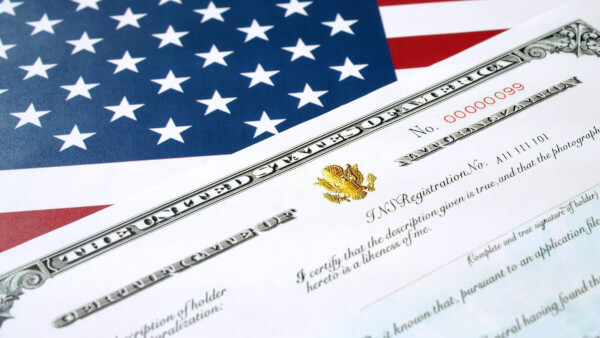Transferring your international driver's license to the US: step-by-step
Your full guide to updating your foreign driver's license to the US.

If you’re a US citizen and would like to bring your fiancé into the country to get married, you’ll need to arrange a K-1 visa, also known as the fiancé visa. This visa type is available to non-US citizens who intend to marry a US citizen within 90 days of arrival. The marriage must be bona fide, and both partners must intend to remain married.
Organising visa paperwork can be daunting, but this guide has you covered with all you need to know about how to apply for a fiancé visa, the K-1 visa timeline, and fiancé visa costs. We’ll also briefly touch on how you can save money as an expat or new arrival in the US, with Wise. Ready? Let’s dive in.
| 📑 Table of Contents |
|---|
The US fiancé visa — properly known as a K-1 type visa — is intended for US citizens who have foreign partners, and who want to be married in the US¹. It’s important to note that this is not the visa you’d need to bring your spouse into the US if you’re already married — nor is it the right visa if your partner is already in the US prior to marriage.
To arrange a K-1 visa for your partner you’ll need to complete an application form (I-129F)² and pay a fee through the USCIS (US Citizenship and Immigration Services) as sponsor. Your fiancé will then have to apply for a K-1 visa (using Form DS-160) in the embassy closest to their place of residence. Once this is approved, they’ll be able to enter the US³.
Under the terms of the K-1 visa, the marriage must take place within 90 days of entry to the country. Once you marry, your fiancé — now your spouse — is counted as immediate family, which opens the opportunity to apply for permanent resident status in the US. We’ll cover a little more about this option later.
To be eligible to apply for a K-1 visa for your fiancé, you’ll need to meet the following requirements:
The final requirement may be waived if you can demonstrate that meeting your fiancé would have violated social practice in the country in which your partner lives, or if traveling to meet would have caused you great hardship.
There are two distinct steps to arranging a K-1 visa. Firstly the US citizen partner must file an immigrant petition using Form I-129F. Then, once this has been approved, the fiancé (non-US citizen) must also apply for a non immigrant visa to enter the US, using Form DS-160. Let’s look at the basic documents needed for both.
To file Form I-129F you’ll need:
Once the Form I-129F has been processed, the non-US fiancé will have to attend a meeting at the US embassy closest to their home. The following documents are usually required:
The K-1 fiancé visa does not entitle the holder to work. However, once admitted to the US, a holder of the K-1 visa can also apply for authorization to work by completing USCIS Form I-765. This is only valid for 90 days from the point of entry to the US.
Only US citizens can apply for the K-1 visa for their fiancé. Green Card holders do not have this right.

Because the K-1 visa involves 2 applications in 2 separate countries it can seem a little complex. Luckily we’re here to break it all down.
Firstly the US citizen partner must complete Form I-129F — Petition for Alien fiancé.
You can download the document from the USCIS website and complete it online, before printing and sending to USCIS. The address you need will depend on whether you’re using USPS or another service, so do check on the USCIS website before you get started. If you’d rather complete the form by hand you can also do that — print the document and fill it in using a black pen.
Once this application is approved it is passed to the National Visa Centre (NVC) which will then pass it to the Embassy closest to the residence of the non-US partner. You’ll be notified by mail when this happens, and can then ask your fiancé to complete the next step.
Once the USCIS filing is completed, the next stage is to complete Form DS-160 and arrange an interview with the US Embassy closest to the home of the non-US partner. The exact process for arranging this interview will vary according to location, so check directly with your local Embassy or Consular service.
Your partner will need to complete the DS-160 form online⁴, and take along a printed copy to the embassy interview along with the other required documents (see list in the document section above for more on this).
During the interview, a consular officer will check whether or not the applicant is eligible for a K-1 visa. They may ask for additional information or evidence to show the relationship is genuine, or to prove that the applicant can comply with all the other eligibility requirements.
If the K-1 visa is approved your partner can travel to the US. They’ll be given a sealed packet of documents by the Embassy at the same time the consular officer issues the K-1 visa. This packet must be left sealed and presented to the border official upon entry to the US.
After arrival, you’ll have 90 days to get married in accordance with the visa terms.
Once the I-129 form is approved, you’ll have 4 months to complete the second stage of completing the DS-160 and attending an interview. The K-1 visa, once issued, will have a 6 month validity, which means the non-US partner will need to enter the country within 6 months, and marry no more than 3 months after that.
There are 2 stages to the application for a K-1 visa. The US based partner will need to complete Form I-129 and file it by mail with USCIS. The non-US fiancé will have to file their application online initially and then attend an interview in person at the US embassy closest to their place of residence.
You’ll be able to check the case status for the initial part of the application — the Form I-129F online, on the USCIS website.
Once the case has been passed to the second stage — completing Form DS-160 and the accompanying interview — the length of time it’ll take will vary by Embassy location. You’ll be able to get an estimate directly from the Embassy which will be dealing with the application, or check the likely wait time online on the Department of State website⁵.
The filing fee for Form I-129 is 535 USD. Filing the DS-160 and attending an interview will cost a further 265 USD⁶.
If you’re paying the fees for your K-1 visa from any currency other than US dollars, you need Wise.
| 💡 Wise offers currency exchange using the real mid-market exchange rate and no hidden fees — and to make life even easier you can get the Wise Multi-currency Account to send, hold and manage money across multiple currencies. |
|---|
Using Wise can mean you save 6x compared to using your regular bank account when you send money overseas, or spend in a foreign currency.
Check how much you can save with Wise
Once your application has been filed, you can see how it’s progressing through the system on the USCIS website. Enter your case number, to track the status of your application on the handy online tool.
Under the terms of your K-1 visa, you’ll have 90 days to enter into a bona fide (good faith) marriage with your partner. Once you’re legally married, your spouse is counted as an immediate relative⁷ in the eyes of the immigration authorities, which then gives them the right to apply for a Green Card — permanent resident status in the US.
Getting a Green Card gives more rights and freedoms than a K-1 visa — and as it confers indefinite right to remain in the US, you’ll also avoid the hassle of needing to renew or extend visas from time to time⁸. It’s not the same as being a US citizen, but it is one step on the journey to naturalizing as a US citizen if your intention as a couple is to stay in the US for the long term.
While there are many different categories under which you can apply for a Green Card, most categories come with annual caps which mean it takes a long time to process your paperwork. Immediate family applications, however, are different. There is no annual cap, which means you can submit your paperwork all at once, and avoid the wait time for a visa number.
Check out the full details on the USCIS website to see the documents you need to support your application, and the fees you’ll have to pay. And if you want to read more on the topic, here are a few other handy articles:
If you’re moving to the US to marry, you’ll need easy ways to manage your money across currencies, and make international payments without breaking the bank.
Meet Wise. Wise international payments use the real mid-market exchange rate with no markups or hidden fees. Send money abroad with Wise to make considerable savings versus your regular bank — and because all transfers are set up and executed online, there’s no need to visit a branch or stand in line to get your payment organised.
You could save even more with the Wise Multi-currency Account. Hold, spend and send a range of foreign currencies, and save 6x compared to traditional banks. Switch between currencies using the real mid-market exchange rate, and get local bank details for the US — as well as other major countries and regions — to receive payments for free. You’ll also get a linked debit card for simple spending and ATM withdrawals all over the world, and can manage your money on the go with the intuitive Wise app.
Immigration paperwork is nobody’s favorite thing. But getting a K-1 visa can be the start of a whole new chapter for you and your partner. Use this guide to get familiar with the K-1 application process — and don’t forget to check out Wise to cut the costs of your daily life as a new arrival in the US.
Sources:
Sources checked on 06.23.2021
*Please see terms of use and product availability for your region or visit Wise fees and pricing for the most up to date pricing and fee information.
This publication is provided for general information purposes and does not constitute legal, tax or other professional advice from Wise Payments Limited or its subsidiaries and its affiliates, and it is not intended as a substitute for obtaining advice from a financial advisor or any other professional.
We make no representations, warranties or guarantees, whether expressed or implied, that the content in the publication is accurate, complete or up to date.

Your full guide to updating your foreign driver's license to the US.

Whatever your reason is for moving to the US, this guide aims to help you figure out the most important costs you'll face when you live there.

Find all you need to know about getting a personal loan for H-1B visa holders in this guide.

Everything you need to know about the US certificate of naturalization.

The US welcomes large numbers of new arrivals every year — and getting a great job to both gain experience and set down roots is a core part of the American...

Find out everything about dual citizenship, as well as whether the US allows it, in this handy guide.